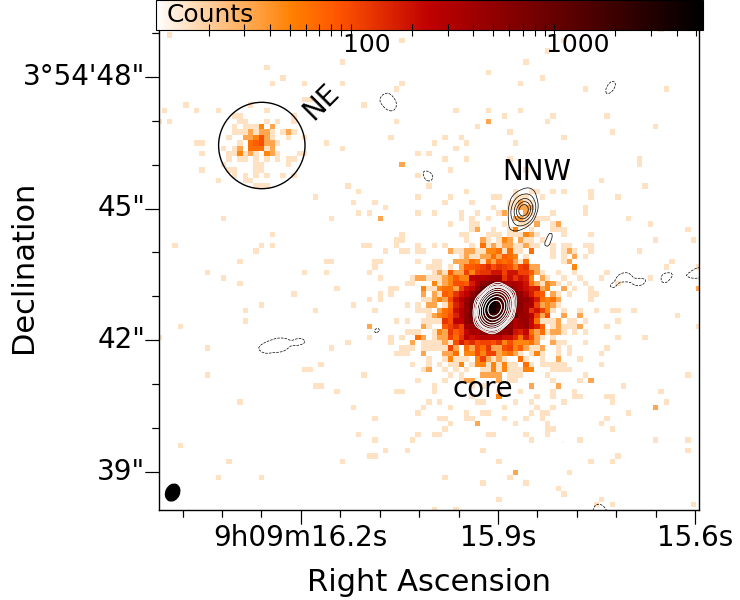
A multi-frequency view on the pc- and kpc-scale morphology of the high-redshift quasar J0909+0354
by Krisztina Perger, Konkoly Observatory, ELKH Research Centre for Astronomy and Earth Sciences, Hungary

Active galactic nuclei (i.e. accreting supermassive black holes in centres of galaxies) are powerful objects exhibiting strong emission at various wavebands. It is well established that radio emission originates from the synchrotron processes in a pair of relativistic jets. However, the origins of X-ray radiation are still under debate (e.g. self- or external inverse Compton scattering of the charged particles in the jet).
To date, imaging observations for less than twenty high-redshift (z>3) quasars are available with the 0.5” resolution Chandra X-ray space telescope. The quasar PMN J0909+0354 (at z=3.288) is among this scarce sample. This quasar was known to have a double radio morphology at kiloparsec scales resolved with the Very Large Array (VLA): a compact core and a secondary component to the north-northwestern direction (NNW).
In the framework of pilot observations of high-redshift quasars with Chandra, apart from the two components coinciding with the radio structure, an additional X-ray-emitting region was identified towards the north-eastern direction (NE) with respect to the core. To uncover the relation between the three components, follow-up observations were conducted with Chandra (P.I.: D. Schwartz) in the 0.5-7 keV energy range, and with the European VLBI Network (EVN; P.I.: K. Perger) at 5 GHz. Additionally, archival global VLBI network, Very Long Baseline Array (VLBA), and VLA data sets were utilized in the study.

J0909+0354 with overlaid contours
indicating the 6.2-GHz VLA observations.
Fitting Gaussian model components to the visibility data of the milliarcsecond-resolution VLBI measurements resulted in multiple jet components on pc scales. The quasar core (i.e. the synchrotron self-absorbed base of the radio jet) shows ~30% flux density variability, and has brightness temperatures exceeding both the theoretical equipartition (5×1010 K) and the empirical (3×1010 K) limits, thus showing Doppler-boosted emission at all epochs of the VLBI observations (Doppler factor δ>2). Assuming various values for the bulk Lorentz factor (5≤Г≤25), the estimated jet inclination angle to the line of sight was found to be Θ<23°. All VLBI observations support the finding that the jet propagates towards the north, implying a connection between the pc-scale jet and NNW. The detailed EVN radio map shows that with increasing distance with respect to the pc-scale core, the radio emission becomes more diffuse, and apparently splits into two branches at ~75 pc (hinting a spine-sheath morphology). Applying a Gaussian (u,v) taper of 0.2 at 10 million wavelength radius to the EVN data set, the pc-scale jet can be traced up to ~250 pc, and bends by ~30° between the pc and kpc scales.
Data from archival VLA measurements at 1.5, 6.2, and 8.5 GHz showed that the kpc-scale radio morphology of the quasar consists of a flat-spectrum core and steep-spectrum NNW component, the latter showing a spectral steepening with increasing frequency, i.e. radiation losses due to spectral aging. Photon counts of the Chandra data give further confirmation on the physical connection of the core with NNW, as an enhanced jet-like emission can be identified in the region between the two components. The detection of X-ray and radio emission, the steep radio spectral index, the jet-like feature in the 1.5 GHz VLA and 0.5-7 keV Chandra images all support the idea of NNW being the kpc-scale hotspot of the quasar on the approaching side of the jet.
From data sets of all the VLBI networks, Chandra, and VLA, it was concluded that J0909+0354 shows characteristics of blazars (e.g. compact, variable, Doppler-enhanced pc-scale core, small jet inclination angle), its pc-scale jets propagates towards the north, and is most likely fueling the NNW component at kpc scales, which is believed to be a hotspot of the quasar. Optical identification in DECaLS and Pan-STARRS, and the direction of the pc-scale jet suggests that NE is most likely a foreground or background object. On the other hand, mid-infrared emission extending up to ~160 kpc surrounding all three regions on kpc scales identified in maps observed by the Wide-field Infrared Survey Explorer might suggest some kind of physical interaction between J0909+0354 and NE.
Published in: Perger et al, 2021, ApJ, 915, 98